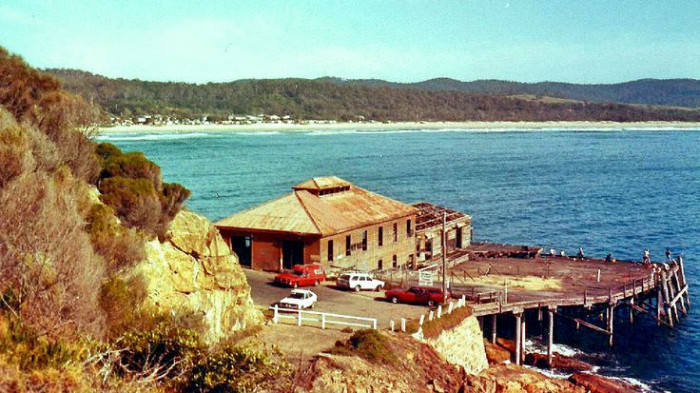South Coast NSW History Story
Tathra Wharf
Tathra Wharf is the only surviving open sea wharf on the eastern seaboard of Australia. In NSW alone, there were once 15 of them.
The wharf evolved over time, and has an interesting history:
Farmers near Bega needed to get their produce to market as quickly and economically as possible. Coastal shipping called at Eden and, sea conditions permitting, at Merimbula. But taking goods to Merimbula from the Bega area involved a 30km longer return journey over steep, rough tracks than did the trip to Tathra…and Eden was even further away. So Tathra presented a very much closer, more-enticing alternative.
Initially coastal vessels anchored offshore of either Kangarutha or Kianinny (inlets just south of Tathra) and local goods were taken out in small boats to coastal vessels anchored offshore.
Around 1860, at the initiative of Daniel Gowing, a farmer at Jellat (between Tathra and Bega), a small wharf was built at Tathra. A more substantial jetty was erected at the same site in 1862. (Gowing also built the first road from Jellat to Bega and to Tathra, and in 1859 built a store at Kianinny that held goods for shipping.)
This wharf was gradually extended and improved: for example, a cargo shed was added in 1866; the wharf was widened in 1873 and extended in 1874, extended again in 1889 and 1903; cattle and pig yards were added in 1903; a new, two-storey cargo shed was erected in 1903; a crane, cattle races, loading ramps and a passenger shelter shed were built between 1907 and 1912.
The town of Tathra was established and grew as a result of the activity surrounding the wharf, and coastal shipping (and particularly that provided by the Illawarra and South Coast Steam Navigation Company) regularly used the wharf and its associated facilities.
The last regular ISN vessel to call at the Tathra wharf was the Cobargo in 1954. Later that same year, the Bergalia called at the wharf to remove remaining slings, ropes, barriers, buoys and a crane.
The wharf then fell into disrepair and in 1973 the NSW Department of Public Works declared that it was unsafe and proposed to demolish it.
This sparked community outrage and, in 1977, ultimately led to the establishment of a Tathra Wharf Trust (a combination of a local Tathra Wharf Action Committee, the National Trust and the Bega and Imlay Shire Councils) that succeeded in leasing the wharf from the Department of Public Works so it could be restored.
This occurred, and the wharf was officially reopened in December 1988. It has since become a popular fishing and tourist attraction, with a café and (well-presented, interesting) museum now occupying the old cargo shed.
Apart from the Tathra Wharf being the sole remaining open sea wharf on the eastern seaboard of Australia, it has other significant heritage values:
• it is a relic of a transport system that played an integral role in the settlement and development of the colony of NSW, and in particular, the towns of the Bega Valley and those of the Monaro;
• it was the main shipping point on the NSW far South Coast for produce from the rich Bega Valley and reflects Tathra’s importance as the area’s prime transport access point during the era of coastal shipping;
• it was a barometer of the economic development of Tathra, the Bega Valley and the Monaro District when shipping was their only real trade and communication link to the outside world;
• it is an important example of a timber wharf from the nineteenth and early twentieth centuries. It reveals aspects of construction and design practices in the engineering of timber marine structures over a 150-year period from the 1860s. Although of simple design the cargo shed is a fine example of marine architecture and displays elements of high quality workmanship and timber construction methods;
• the wharf and cargo shed are important relics for those researching the construction of heavy timber maritime structures and their maintenance;
• it is evidence of a working wharf from a bygone era;
• it is an example of the successful conservation of a timber marine structure in a harsh environment;
• it was constructed under E O Moriarty, one of the most important colonial engineers, and was extended by E M de Burgh, another eminent colonial engineer, both of whom were at one time Engineer-in-Chief of the Harbours and River Navigation Branch of the NSW Department of Public Works;
• it is an excellent demonstration of what can be achieved through determined local heritage advocacy and activism.
Picture: Tathra Wharf prior to restoration.
